1. Good projection of sound to the rear of the enclosure -> long enough reverberation time.
Reverberation is the collection of reflected sounds from the surfaces in an enclosed space. It is a desirable property to the extent that it helps to overcome the inverse square law dropoff of sound intensity in the enclosure. The inverse square law shows that as sound travels further, the sound twice as far from the source is spread over four times the area, lowering the intensity of sound.
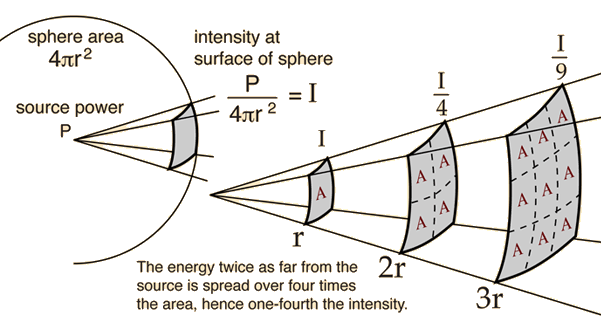
2. Good clarity and articulation -> reverberation time not too long.
The desirable reverberation time is 1.5 to 2.5 seconds. Highly reflective surfaces lengthen the reverberation time while absorbing surfaces shorten the reverberation time. When a sound wave in a room strikes a surface, a fraction of it is absorbed while a fraction is transmitted into the surface. Both of these amounts are lost from the room. The effective absorbing area is a factor in determining the reverberation time of an enclosed space. The absorption coefficient of a surface typically changes with frequency, making the reverberation time frequency dependent. The absorption coefficients of different surface materials can be used to calculation the reverberation time with the Sabine formula.
Absorption coefficient = a
Effective absorbing area = aS

where V is the volume of the enclosure and

Table of Absorption Coefficients
| Nature of surface | ||||||
| 125 | 250 | 500 | 1000 | 2000 | 4000 | |
| Acoustic tile, rigid mount | 0.2 | 0.4 | 0.7 | 0.8 | 0.6 | 0.4 |
| Acoustic tile, suspended | 0.5 | 0.7 | 0.6 | 0.7 | 0.7 | 0.5 |
| Acoustical plaster | 0.1 | 0.2 | 0.5 | 0.6 | 0.7 | 0.7 |
| Ordinary plaster, on lath | 0.2 | 0.15 | 0.1 | 0.05 | 0.04 | 0.05 |
| Gypsum wallboard, 1/2" on studs | 0.3 | 0.1 | 0.05 | 0.04 | 0.07 | 0.1 |
| Plywood sheet, 1/4" on studs | 0.6 | 0.3 | 0.1 | 0.1 | 0.1 | 0.1 |
| 0.4 | 0.4 | 0.3 | 0.3 | 0.4 | 0.3 | |
| Concrete block, painted | 0.1 | 0.05 | 0.06 | 0.07 | 0.1 | 0.1 |
| Concrete, poured | 0.01 | 0.01 | 0.02 | 0.02 | 0.02 | 0.03 |
| Brick | 0.03 | 0.03 | 0.03 | 0.04 | 0.05 | 0.07 |
| Vinyl tile on concrete | 0.02 | 0.03 | 0.03 | 0.03 | 0.03 | 0.02 |
| Heavy carpet on concrete | 0.02 | 0.06 | 0.15 | 0.4 | 0.6 | 0.6 |
| Heavy carpet on felt backing | 0.1 | 0.3 | 0.4 | 0.5 | 0.6 | 0.7 |
| Platform floor, wooden | 0.4 | 0.3 | 0.2 | 0.2 | 0.15 | 0.1 |
| Ordinary window glass | 0.3 | 0.2 | 0.2 | 0.1 | 0.07 | 0.04 |
| Heavy plate glass | 0.2 | 0.06 | 0.04 | 0.03 | 0.02 | 0.02 |
| Draperies, medium velour | 0.07 | 0.3 | 0.5 | 0.7 | 0.7 | 0.6 |
| 0.2 | 0.4 | 0.6 | 0.7 | 0.6 | 0.6 | |
| Upholstered seating, occupied | 0.4 | 0.6 | 0.8 | 0.9 | 0.9 | 0.9 |
| Wood seating, unoccupied | 0.02 | 0.03 | 0.03 | 0.06 | 0.06 | 0.05 |
| Wooden pews, occupied | 0.4 | 0.4 | 0.7 | 0.7 | 0.8 | 0.7 |
3. Good balance of low and high frequencies -> reverberation time for low frequencies longer than for high frequencies.
It is common for distant listeners to experience a deficient in bass. This problem is caused by the characteristic of the ear since the ear shows progressively greater discrimination against low frequencies as the sound gets softer. To solve the problem, we have to design the auditorium so that its reverberation time for low frequencies is greater than that for high frequencies. This can be achieved if a lot of wood is used in the construction since the wood absorbs high frequencies more than lows. However typical thin wood paneling on the suds selectively absorbs low frequencies and thus should be avoided in auditoriums.
The graph shows a progression to higher reverberation times for low frequencies. It is typical for the reverberation time for low frequencies for a good auditorium to be some 30% higher than the overall average reverberation time. This characteristic helps to deal with the bass loss problem, one of the fundamental problems of auditorium acoustics.
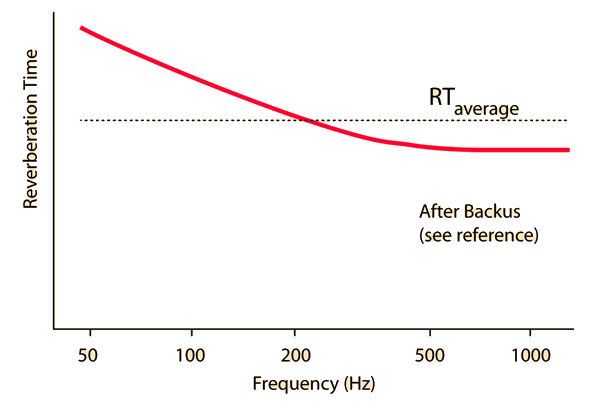
Auditorium Examples
The auditoriums cited below are some of the most outstanding in the world, and they show the consistent pattern of having significantly longer reverberation times for low frequencies.| Symphony Hall, Boston | ||||
| Orchestra Hall, Chicago | ||||
| Severance Hall, Cleveland | ||||
| Carnegie Hall, New York | ||||
| Opera House, San Francisco | ||||
| Arie Crown Theatre, Chicago | ||||
| Royal Festival Hall, London | ||||
| Royal Albert Hall, London | ||||
| Concertgebouw, Amsterdam | ||||
| Kennedy |
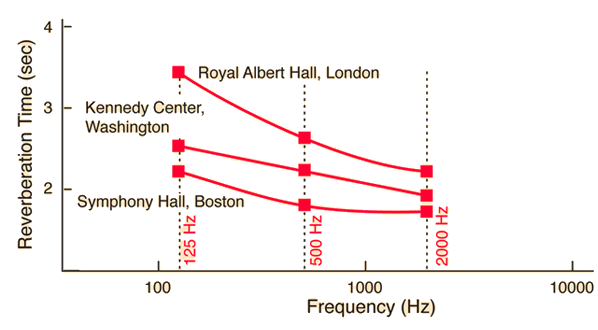
Any time the surfaces of a room focus the sound which is reflected from them, they create spots of high intensity and other spots with low intensity. This is generally undesirable in an auditorium since you want a uniform, evenly dispersed sound to all listeners.
Even large flat reflective surfaces are to be avoided because of the prominent reflection which will be produced. Parallel flat walls can produce a pattern of reflections known as a "flutter echo" as the sound waves travel back and forth between the surfaces. Such flutter echoes are often encountered in high
Even dispersion is such an important contributor to good acoustics that it is sometimes desirable to use anti-focusing surfaces in a music making area. Older architecture often had columns, decorative sculpture and woodwork, and other dispersing surfaces. In modern architecture with its flat expanses, it is necessary to design in some anti-focusing properties.
Examples of reflective geometries:
Elliptical enclosure
Parabolic Surfaces
Rotunda Effect
Anti-focusing Surfaces
\
5. A feel of "intimacy" or "presence" -> short delay between direct and first reflected sound.
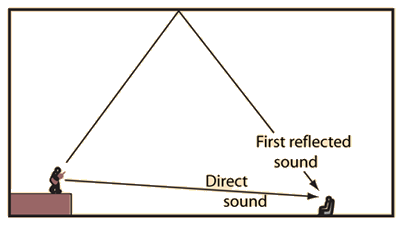 | A large difference between the time of arrival of the direct sound and the first reflected sound is perceived by the listener as a sense of isolation from the performance. Terms used are that the performance lacks "presence" and "intimacy". |
| Comparative | 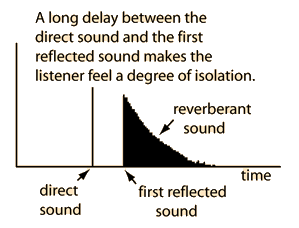 |
Source:
http://hyperphysics.phy-astr.gsu.edu/hbase/acoustic/arcaco.html#c1
No comments:
Post a Comment